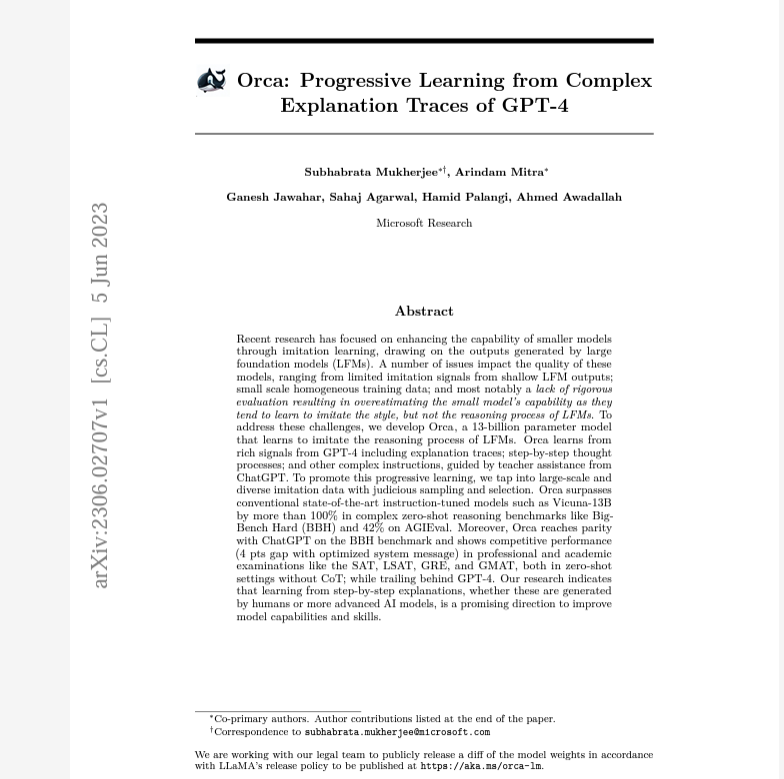
In the fast-paced world of artificial intelligence, new advancements and breakthroughs often come as a surprise. One such surprise is the emergence of Orca, a model that has caught many off guard with its remarkable capabilities. In this article, we will delve into the fascinating story of Orca, exploring its origins, its performance, and what it means for the future of AI.
A Microsoft Marvel
To begin our journey, it’s important to note that all the research behind Orca has been conducted by Microsoft, which adds an intriguing twist to the tale. Microsoft’s involvement raises questions about their motivations and long-term AI strategies. Could this research be a response to the ever-growing dominance of proprietary models? Only time will tell.
Orca’s primary objective was to address the limitations of other open-source models in terms of both style and reasoning. While these models excelled in mimicking the style of language, they often fell short in terms of factual accuracy and complex reasoning. Orca sought to bridge this gap by developing a 13 billion parameter model that learned to imitate the reasoning process of larger models.
Learning from the Giants
Orca’s journey to success involved leveraging the knowledge and guidance of its larger counterparts, such as GPT 3.5 and GPT 4. It learned by carefully observing the step-by-step thought processes of these models, guided by teacher assistance from Chachi PT (GPT 3.5). This approach allowed Orca to gain valuable insights into the reasoning behind responses and incorporate them into its own learning process.
Surpassing Expectations
The results of Orca’s training and evaluation are nothing short of impressive. In various benchmarks and tests, Orca outperformed other open-source models by a significant margin. In fact, it even matched GPT 4 in tests of reasoning ability.
Notably, Orca surpassed conventional state-of-the-art models like Vicuna by more than 100% in complex zero-shot reasoning benchmarks. These achievements highlight the model’s remarkable potential and the effectiveness of its training methodology.
Size Isn’t Everything?
One intriguing aspect of Orca is its relatively smaller size compared to other dominant models. With 13 billion parameters, Orca is just a fraction of the size of models like GPT 3 or GPT 4. Yet, it manages to deliver competitive performance and even outperforms models with significantly larger parameter counts. This smaller size allows Orca to be run on more accessible devices, making it a promising option for various applications.
The Power of Explanations
A crucial factor contributing to Orca’s success lies in the detailed step-by-step explanations it received during its training. By leveraging system messages and in-depth responses from GPT 4, Orca gained a deeper understanding of the reasoning process. This enabled it to imitate the reasoning capabilities of larger models, ultimately leading to its impressive performance in various tests and benchmarks.
Beyond the Horizon
While Orca’s achievements are undoubtedly remarkable, it’s essential to view them as a starting point rather than the final destination. The authors themselves acknowledge that Orca represents a baseline and that further advancements can be made through techniques like advanced prompting and the utilization of process-based reward models. These possibilities open doors for future enhancements and improvements to Orca’s already impressive capabilities.
To understand the differences between the models please check out the video below.
https://www.youtube.com/watch?v=Dt_UNg7Mchg
,”The video is from “,A,I Explained, and all rights belong to their respective owners”.
The Grand Puzzle: Conclusion
As the story of Orca unfolds, we are reminded of the ever-evolving nature of AI research and development. With each breakthrough, new questions and challenges arise. Will open-source models catch up to their proprietary counterparts? How will Orca’s success impact future AI investments? Only time and continued research will reveal the answers.
In conclusion, Orca’s emergence as a highly capable model has caught many by surprise. Its ability to bridge the gap between style and reasoning, despite its smaller size, showcases the power of innovative training methodologies. As the AI landscape continues to evolve, Orca serves as a testament to the endless possibilities and untapped potential that lies within the realm of artificial intelligence.
Note: The views and opinions expressed by the author, or any people mentioned in this article, are for informational purposes only, and they do not constitute financial, investment, or other advice.
Relevant Articles:
Tree of Thoughts: Supercharging GPT-4 by 900%
Enter PaLM 2 (New Bard) VS ChatGPT-4: Full Breakdown
GPT-4 Seems Smarter than we think: What is SmartGPT?